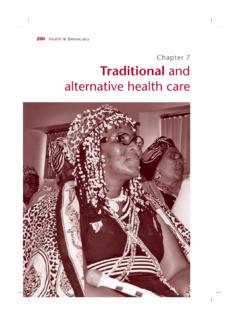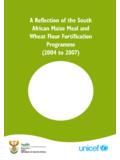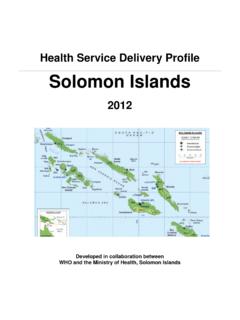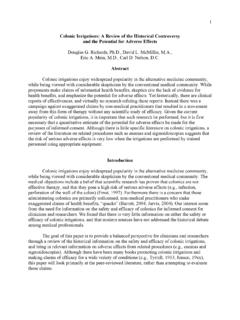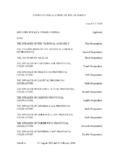Transcription of IN LEBANON 2010 - World Health Organization
1 WHO-AIMS REPORT ON MENTAL Health SYSTEM IN LEBANON 2010 MINISTRY OF Health LEBANON 2 WHO-AIMS REPORT ON MENTAL Health SYSTEM IN LEBANON A report of the assessment of the mental Health system in LEBANON using the World Health Organization - Assessment Instrument for Mental Health Systems (WHO-AIMS). Beirut , LEBANON 2010 Ministry of Health LEBANON (WHO, LEBANON ) (WHO, Regional Office) WHO Department of Mental Health and Substance Abuse (MSD) 3 This publication has been produced by the WHO, ( LEBANON ) in collaboration with WHO, (Regional Office) and WHO, Headquarters. At WHO Headquarters this work has been supported by the Evidence and Research Team of the Department of Mental Health and Substance Abuse, Cluster of Noncommunicable Diseases and Mental Health . For further information and feedback, please contact: 1) Antoine Saad (National advisor for Mental Health LEBANON ) 2) Shekhar Saxena, WHO Headquarters, e-mail: (ISBN) World Health Organization 2010 WHO-AIMS Report on Mental Health System in LEBANON , WHO and Ministry of Health , (Beirut, LEBANON , 2010 ).
2 (Copyright text as per rules of the Country Office) 4 Acknowledgement The World Health Organization Assessment Instrument for Mental Health Systems (WHO-AIMS) was used to collect information on the mental Health system of LEBANON . The project in LEBANON was implemented by WHO-AIMS LEBANON Team : Antoine Saad, Ola Ataya, and Maria Khalife. The preparation of this study was done with the collaboration of the Ministry of public Health (Dr. Walid Ammar and Racha Hamra ) and IMC ( International Medical Corps). The project was also supported by the WHO East Mediterranean regional Office. The World Health Organization Assessment Instrument for Mental Health Systems (WHO-AIMS) has been conceptualized and developed by the Mental Health Evidence and Research team (MER) of the Department of Mental Health and Substance Abuse (MSD), World Health Organization (WHO), Geneva, in collaboration with colleagues inside and outside of WHO.
3 The project received financial assistance and/or seconded personnel from: The National Institute of Mental Health (NIMH) (under the National Institutes of Health ) and the Center for Mental Health Services (under the Substance Abuse and Mental Health Services Administration [SAMHSA]) of the United States; The Health Authority of Region Lombardia, Italy; The Ministry of Public Health of Belgium and The Institute of Neurosciences Mental Health and Addiction, Canadian Institutes of Health Research. The WHO-AIMS team at WHO Headquarters includes: Benedetto Saraceno, Shekhar Saxena, Tom Barrett, Antonio Lora, Mark van Ommeren, Jodi Morris, Grazia Motturi. Additional assistance has been provided by Ryan McBain. The WHO-AIMS project is coordinated by Shekhar Saxena. 5 Executive Summary The World Health Organization Assessment Instrument for Mental Health Systems (WHO- AIMS) was used to collect information on the Mental Health System in LEBANON .
4 The goal of collecting this information is to improve the Mental Health System and to provide a baseline for monitoring change. This will enable LEBANON to develop information-based Mental Health Plans with clear baseline information and targets. It will also be useful to monitor progress in implementing reform policies, providing community services, and involving users, families and other stakeholders in Mental Health promotion, prevention, care and rehabilitation. LEBANON is a small Eastern Mediterranean country with a geographical area of 10452 sq/ km and a population around 4,350,000, including 500,000 refugees from different nationalities, most being Palestinians. The country belongs to the upper-middle income group with a diversity of 18 religions. The mental Health system benefits from different acts and legislations in different areas of mental Health , namely: 1) Lebanese Act no 72-9/9/1983 Welfare Act and Protection and Treatment of Mentally Ill Patients.
5 2) Lebanese Act no 673-16/3/1998 Narcotic Drugs and Psychotropic Substances and Precursors. 3) Lebanese Act no 220-29/5/2000 Rights of Mentally Handicapped in LEBANON 4) Lebanese Act no 574-11/2/2004 Patients Rights and Informed Consent Despite the presence of the above Acts, LEBANON is still not capable of enforcing and implementing human rights and protective laws for the mentally ill. The budget for Mental Health constitutes 5% of the general Health budget, mainly devoted to cover long stay inpatient cost in private mental hospitals whereas outpatient community based services are the responsibility of the private sector with no budget except for those providing certain psychotropic medicines for free. However, expenditures on mental Health are still far below the needs. In terms of availability of mental Health facilities, the system still suffers from an imbalance with a crucial lack of community-based services such as residential or day treatment facilities.
6 The mental Health services should be organized in terms of catchment/ service areas because the MOH should be responsible for the provision of care to the population of every region in the country. The essential list of psychotropic drugs is regularly updated and includes anti psychotics, antidepressants, anxiolytics, mood stabilizers and antiepileptics. Only doctors are allowed to prescribe without restrictions. There is no interaction with traditional healers/ practitioners who are not legally recognized. The country also suffers from a shortage of mental Health professionals (psychiatric nurses and psychiatrists). Little research is carried out by personal initiative, therefore the need for national technical committee for mental Health providing advice to the government on mental Health policy legislation and service planning is necessary. 6 Mental Health action plan. Critical next steps in reforming the mental Health system include: Prevention and promotion of mental Health (Mental Health Awareness campaign) Creating a Mental Health department within the MOH general healthcare system Development of mental Health national policy Developing a mental Health information system Strengthening community-based facilities mainly public mental Health outpatient facilities to provide availability of services in the 6 Lebanese districts Integration of mental Health in community-based primary healthcare settings in order to move from Mental hospitals to community-based services.
7 Mental Health training for pre/post-graduate healthcare providers on emotional & psychosocial Health in different Health & educational institutions. Implementation of mental Health activities in prisons (psychosocial rehabilitation programs for detainees) Creation of public substance abuse disorder (SUD)s treatment centers in/outpatient (detoxification, OST) Mapping primary Health care center for referral and networking Behavioral Science rotation in medical schools should be mandatory and not elective Updating The Mental Health Act Creation of a national intelligence multidisciplinary committee with key people and experts in the fields of mental Health , public relations, marketing, advertising, media, management, journalism, research etc. to study the needs, prioritize action steps, using logistics and setting a plan of execution while spreading awareness and educating 7 Introduction LEBANON is situated at the Eastern end of the Mediterranean sea with a geographical area of 10,452 sq km and a total population of 4,055,000 million (WHO 2005).
8 From east to west it averages 50 km and is about 225 km from north to south. Two mountain ranges run parallel to each other down the length of the country: the Mount LEBANON and the Anti- LEBANON ranges. Between the two ranges lies the fertile plain of the Bekaa Valley, through which the Orontes (Assi) and Litani rivers flow. The climate is Mediterranean with mild to cool, wet winters and hot, dry summers.. The main languages used in the country are Arabic, English, and French. Ethnic background is an important factor in LEBANON . The country encompasses a great mix of cultural, religious, and ethnic groups which have been building up for more than 6,000 years. Although most of the population is today considered Arab, in the sense that Arabic is the national language, the ethnic self designations vary. Lebanese are overall genetically similar to the Phoenicians, and the Canaanites, as well as other modern Levantine populations, such as Syrians, Palestinians, and Jordanians.
9 The question of ethnic identity has come to revolve more around aspects of cultural self-identification more than descent. Religious affiliation has also become a substitute in some respects for ethnic affiliation. The present Lebanese constitution officially acknowledges 18 religious groups. Religious groups include Alawite, Armenian Catholic, Armenian Orthodox, Assyrian, Chaldean Catholic, Copts, Druze, Evangelical Christian, Greek catholic, Greek orthodox, Isma ili, Jewish, Maronite, Roman Catholic, Sunni, Shi a, Syriac Catholic, Syriac Orthodox. The small ethnic minority population includes Lebanese Armenians, Assyrians, Jews, Kurds, and Persians. The country is an upper-middle income group country based on World Bank 2009 criteria. 28% percent of the population is under the age of 15 and 9% of the population are over the age of 60 (WHO 2005). 15% percent of the population is rural. The life expectancy at birth is for males and 72 for females (WHO 2005).
10 The healthy life expectancy at birth is 59 for males and 62 for females (WHO 2005). The literacy rate for men is and the for women (Unesco /MOH 2004). The proportion of the Health budget to GDP is The total per capita expenditure in Health equals $673 and the per capita government expenditure is $189 (WHO 2004). Government expenditures on mental Health are 5% of the total Health budget. There are 3 mental hospitals and 5 psychiatric units within general hospitals. There are a total of 43 psychiatric beds per 10,000 population (figure includes both psychiatric beds in general hospitals and mental hospitals. Two psychiatrists per 100,000 populations can be found. LEBANON depends mainly on the private sector for the provision of the Health services. The Ministry of Health has contracts with the private sector in order for the needy patients to receive free treatment. There are no disability benefits for persons with mental disorders and no disability funding for mental Health (Mental Health Atlas 2005).)










![Traditional Helath Practitioners Act [No. 35 of 2004]](/cache/preview/c/7/d/4/5/8/f/6/thumb-c7d458f692bae21cab4d196ac02eea51.jpg)
